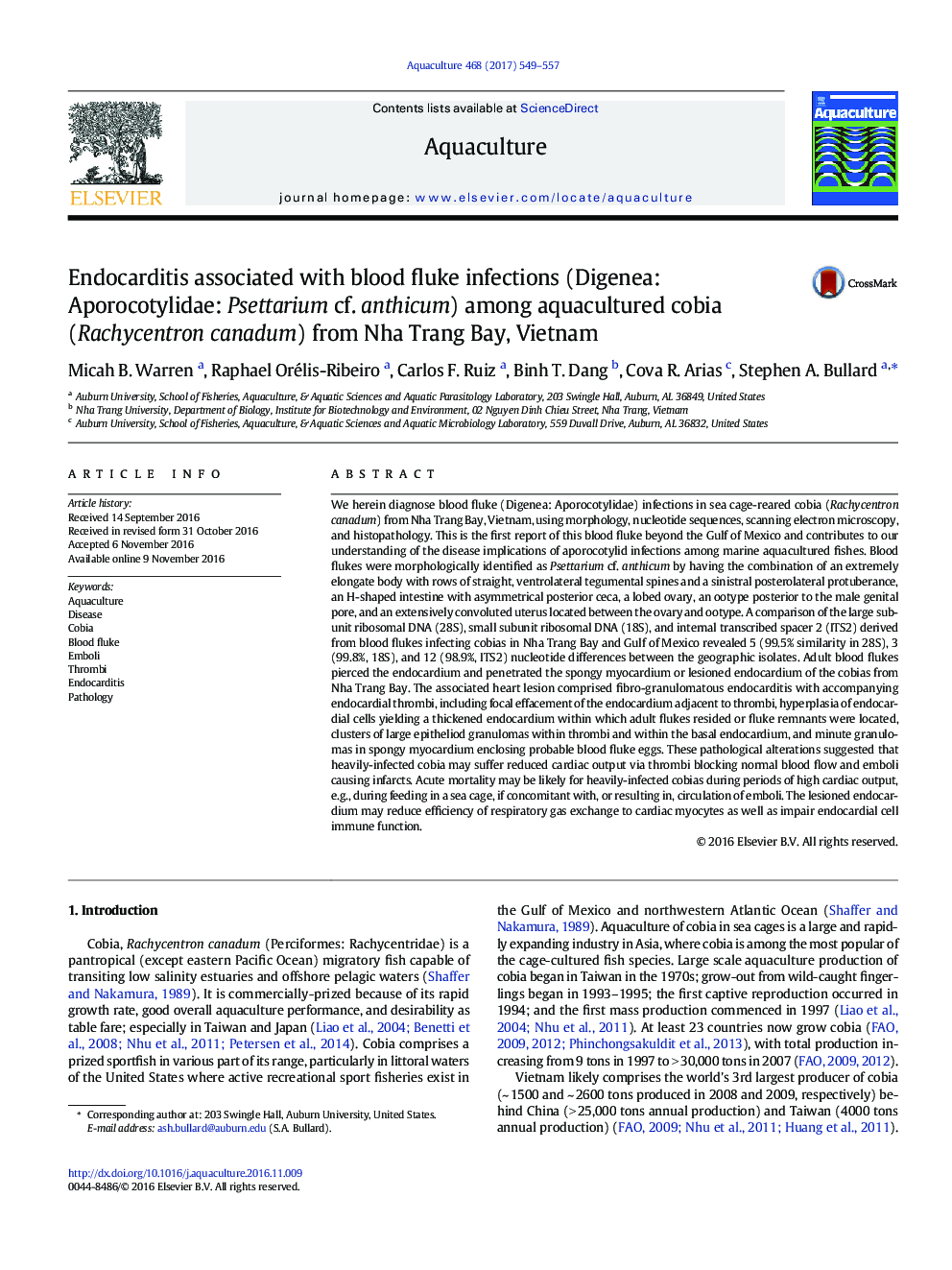| کد مقاله | کد نشریه | سال انتشار | مقاله انگلیسی | نسخه تمام متن |
|---|---|---|---|---|
| 5539442 | 1402422 | 2017 | 9 صفحه PDF | دانلود رایگان |
عنوان انگلیسی مقاله ISI
Endocarditis associated with blood fluke infections (Digenea: Aporocotylidae: Psettarium cf. anthicum) among aquacultured cobia (Rachycentron canadum) from Nha Trang Bay, Vietnam
دانلود مقاله + سفارش ترجمه
دانلود مقاله ISI انگلیسی
رایگان برای ایرانیان
کلمات کلیدی
موضوعات مرتبط
علوم زیستی و بیوفناوری
علوم کشاورزی و بیولوژیک
علوم آبزیان
پیش نمایش صفحه اول مقاله

چکیده انگلیسی
We herein diagnose blood fluke (Digenea: Aporocotylidae) infections in sea cage-reared cobia (Rachycentron canadum) from Nha Trang Bay, Vietnam, using morphology, nucleotide sequences, scanning electron microscopy, and histopathology. This is the first report of this blood fluke beyond the Gulf of Mexico and contributes to our understanding of the disease implications of aporocotylid infections among marine aquacultured fishes. Blood flukes were morphologically identified as Psettarium cf. anthicum by having the combination of an extremely elongate body with rows of straight, ventrolateral tegumental spines and a sinistral posterolateral protuberance, an H-shaped intestine with asymmetrical posterior ceca, a lobed ovary, an ootype posterior to the male genital pore, and an extensively convoluted uterus located between the ovary and ootype. A comparison of the large subunit ribosomal DNA (28S), small subunit ribosomal DNA (18S), and internal transcribed spacer 2 (ITS2) derived from blood flukes infecting cobias in Nha Trang Bay and Gulf of Mexico revealed 5 (99.5% similarity in 28S), 3 (99.8%, 18S), and 12 (98.9%, ITS2) nucleotide differences between the geographic isolates. Adult blood flukes pierced the endocardium and penetrated the spongy myocardium or lesioned endocardium of the cobias from Nha Trang Bay. The associated heart lesion comprised fibro-granulomatous endocarditis with accompanying endocardial thrombi, including focal effacement of the endocardium adjacent to thrombi, hyperplasia of endocardial cells yielding a thickened endocardium within which adult flukes resided or fluke remnants were located, clusters of large epitheliod granulomas within thrombi and within the basal endocardium, and minute granulomas in spongy myocardium enclosing probable blood fluke eggs. These pathological alterations suggested that heavily-infected cobia may suffer reduced cardiac output via thrombi blocking normal blood flow and emboli causing infarcts. Acute mortality may be likely for heavily-infected cobias during periods of high cardiac output, e.g., during feeding in a sea cage, if concomitant with, or resulting in, circulation of emboli. The lesioned endocardium may reduce efficiency of respiratory gas exchange to cardiac myocytes as well as impair endocardial cell immune function.
ناشر
Database: Elsevier - ScienceDirect (ساینس دایرکت)
Journal: Aquaculture - Volume 468, Part 1, 1 February 2017, Pages 549-557
Journal: Aquaculture - Volume 468, Part 1, 1 February 2017, Pages 549-557
نویسندگان
Micah B. Warren, Raphael Orélis-Ribeiro, Carlos F. Ruiz, Binh T. Dang, Cova R. Arias, Stephen A. Bullard,